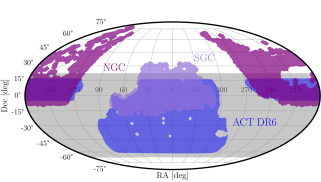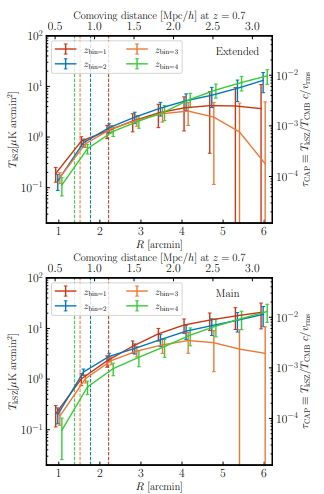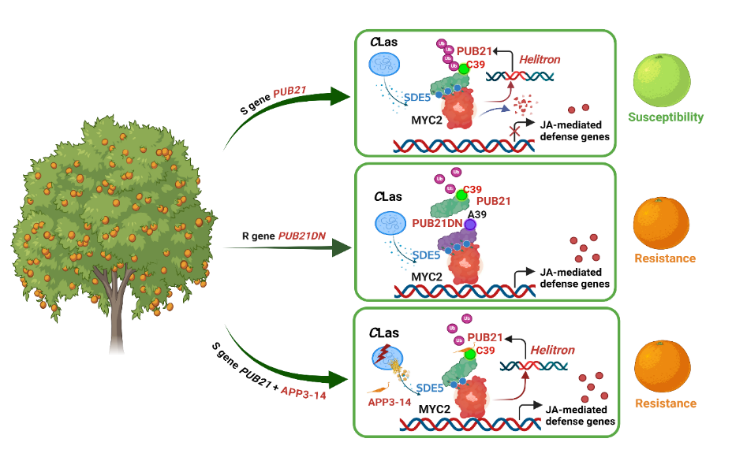2025-04-11 カリフォルニア大学バークレー校(UCB)
<関連情報>
- https://news.berkeley.edu/2025/04/11/half-of-the-universes-hydrogen-gas-long-unaccounted-for-has-been-found/
- https://arxiv.org/abs/2503.19870
- https://journals.aps.org/prd/abstract/10.1103/PhysRevD.111.023534
- https://arxiv.org/abs/2407.07152
光度の高い赤い銀河の周りの拡張ガスハローをバックライトで照らす:DESI Y1 x ACTによる運動学的スンヤエフ・ツェルドビッチ効果 Backlighting extended gas halos around luminous red galaxies: kinematic Sunyaev-Zel’dovich effect from DESI Y1 x ACT
Bernardita Ried Guachalla, Emmanuel Schaan, Boryana Hadzhiyska, Simone Ferraro, Jessica N. Aguilar, Steven Ahlen, Nicholas Battaglia, Davide Bianchi, Richard Bond, David Brooks, Todd Claybaugh, William R. Coulton, Axel de la Macorra, Mark J. Devlin, Arjun Dey, Peter Doel, Jo Dunkley, Kevin Fanning, Jaime Forero-Romero, Enrique Gaztañaga, Satya Gontcho A Gontcho, Gaston Gutierrez, Julien Guy, J. Colin Hill, Klaus Honscheid, Stephanie Juneau, Theodore Kisner, Anthony Kremin, Andrew Lambert, Martin Landriau, Laurent Le Guillou, Niall MacCrann, Marc Manera, Aaron Meisner, Ramon Miquel, Kavilan Moodley, John Moustakas, Tony Mroczkowski, Adam D. Myers, Michael D. Niemack, Gustavo Niz, Nathalie Palanque-Delabrouille, Will Percival, Ignasi Pérez-Ràfols, Claire Poppett, Francisco Prada, Frank J. Qu, Graziano Rossi, Eusebio Sanchez, David Schlegel, Michael Schubnell, Hee-Jong Seo, Cristóbal Sifón, David N. Spergel, David Sprayberry, Gregory Tarlé, Mariana Vargas-Magaña, Eve M. Vavagiakis, Benjamin A. Weaver, Edward J. Wollack, Pauline Zarrouk
arXiv Submitted on 25 Mar 2025
DOI:https://doi.org/10.48550/arXiv.2503.19870

Abstract
The gas density profile around galaxies, shaped by feedback and affecting the galaxy lensing signal, is imprinted on the cosmic microwave background (CMB) by the kinematic Sunyaev-Zel’dovich effect (kSZ). We precisely measure this effect (S/N≈10) via velocity stacking with 825,283 spectroscopically confirmed luminous red galaxies (LRG) from the Dark Energy Spectroscopic Instrument (DESI) Y1 survey, which overlap with the Atacama Cosmology Telescope (ACT) Data Release 6 temperature maps over ≥4,000deg2. We explore the kSZ dependence with various galaxy parameters. We find no significant trend with redshift, but clear trends with stellar mass and absolute magnitude in g, r, and z bands. We highlight new challenges when comparing data and hydrodynamical simulations. Our simple and most conservative analysis suggests that the gas is more extended than the dark matter (99.5% confidence, i.e. PTE = 0.005). It also hints at a preference for galaxy formation models with more feedback (Illustris z=0.5, PTE = 0.37) rather than less (Illustris TNG z=0.8, PTE = 0.045), though with less statistical significance. In all cases, a free multiplicative amplitude was fit to the simulated profiles, and further modeling work is required to firm up these conclusions. We find consistency between kSZ profiles around spectroscopic and photometric LRG, with comparable statistical power, thus increasing our confidence in the photometric analysis. Additionally, we present the first kSZ measurement around DESI Y1 bright galaxy sample (BGS) and emission-line galaxies (ELG), whose features match qualitative expectations. Finally, we forecast S/N∼50 for future stacked kSZ measurements using data from ACT, DESI Y3, and Rubin Observatory. These measurements will serve as an input for galaxy formation models and baryonic uncertainties in galaxy lensing.
フィラメントとハローにおける宇宙ガスの追跡: 運動論的スンヤエフ・ツェルドビッチ効果による低赤方偏移の洞察 Tracing cosmic gas in filaments and halos: Low-redshift insights from the kinematic Sunyaev-Zel’dovich effect
Boryana Hadzhiyska, Simone Ferraro, and Rongpu Zhou
Physical Review D Published: 24 January, 2025
DOI: https://doi.org/10.1103/PhysRevD.111.023534
Abstract
In this work, we leverage cosmic microwave background (CMB) data from the Atacama Cosmology Telescope (ACT) and LSS data from the imaging survey conducted by the Dark Energy Spectroscopic Instrument (DESI) to study the distribution of gas around galaxy groups at low redshift, ≈0.3, via the kinematic Sunyaev-Zel’dovich (kSZ) effect. In particular, we perform velocity-weighted stacking on the photometric galaxies from the Bright Galaxy Survey (BGS) to isolate the monopole and quadrupole of the kSZ signal, orienting the stacked images along 2D filaments identified using the Hessian of the projected gravitational potential. We find a 7.2 detection in the monopole of the signal (i.e., the gas density profile) and a 4 detection in the quadrupole ( =2), constituting the first measurement of the alignment between gas distribution and the cosmic web through the kSZ effect. As it is a linear probe of the local gas density, the kSZ has heightened sensitivity to the warm-hot intergalactic medium (WHIM), which is believed to house the majority of the “missing baryons.” Mapping out the gas density at low redshifts, as enabled by our measurements, is crucial for weak lensing surveys, for which the impact of baryons on small scales is a major impediment. We compare the anisotropic signal against two hydrodynamical simulations, TNG300-1 and Illustris, which have very different baryonic feedback prescriptions. We find that the anisotropic signal measured in the data is comparable but slightly larger and more extended compared with the simulations. This suggests that there is excess accretion and feedback taking place through the filaments, hinting at the possible presence of spin-filament alignment of the BGS objects.
ACTおよびDESI測光銀河による運動論的スンヤエフ・ツェルドビッチ観測から得られた低・中間赤方偏移における大きなバリオンフィードバックの証拠 Evidence for large baryonic feedback at low and intermediate redshifts from kinematic Sunyaev-Zel’dovich observations with ACT and DESI photometric galaxies
B. Hadzhiyska, S. Ferraro, B. Ried Guachalla, E. Schaan, J. Aguilar, N. Battaglia, J. R. Bond, D. Brooks, E. Calabrese, S. K. Choi, T. Claybaugh, W. R. Coulton, K. Dawson, M. Devlin, B. Dey, P. Doel, A. J. Duivenvoorden, J. Dunkley, G. S. Farren, A. Font-Ribera, J. E. Forero-Romero, P. A. Gallardo, E. Gaztañaga, S. Gontcho Gontcho, M. Gralla, L. Le Guillou, G. Gutierrez, J. Guy, J. C. Hill, R. Hložek, K. Honscheid, S. Juneau, T. Kisner, A. Kremin, M. Landriau, R. H. Liu, T. Louis, N. MacCrann, A. de Macorra, M. Madhavacheril, M. Manera, A. Meisner, R. Miquel, K. Moodley, J. Moustakas, T. Mroczkowski, S. Naess, J. Newman, M. D. Niemack, G. Niz, L. Page, N. Palanque-Delabrouille, B. Partridge, W. J. Percival, F. Prada, F. J. Qu, G. Rossi, E. Sanchez, D. Schlegel, M. Schubnell, N. Sehgal, H. Seo, C. Sifón, D. Spergel, D. Sprayberry, S. Staggs, G. Tarlé, C. Vargas, E. M. Vavagiakis, B. A. Weaver, E. J. Wollack, R. Zhou, H. Zou
arXiv Submitted on 9 Jul 2024
DOI:https://doi.org/10.48550/arXiv.2407.07152

Abstract
Recent advances in cosmological observations have provided an unprecedented opportunity to investigate the distribution of baryons relative to the underlying matter. In this work, we robustly show that the gas is much more extended than the dark matter at 40σ and the amount of baryonic feedback at z≲1 strongly disfavors low-feedback models such as that of state-of-the-art hydrodynamical simulation IllustrisTNG compared with high-feedback models such as that of the original Illustris simulation. This has important implications for bridging the gap between theory and observations and understanding galaxy formation and evolution. Furthermore, a better grasp of the baryon-dark matter link is critical to future cosmological analyses, which are currently impeded by our limited knowledge of baryonic feedback. Here, we measure the kinematic Sunyaev-Zel’dovich (kSZ) effect from the Atacama Cosmology Telescope (ACT), stacked on the luminous red galaxy (LRG) sample of the Dark Energy Spectroscopic Instrument (DESI) imaging survey. This is the first analysis to use photometric redshifts for reconstructing galaxy velocities. Due to the large number of galaxies comprising the DESI imaging survey, this is the highest signal-to-noise stacked kSZ measurement to date: we detect the signal at 13σ and find that the gas is more spread out than the dark matter at ∼40σ. Our work opens up the possibility to recalibrate large hydrodynamical simulations using the kSZ effect. In addition, our findings point towards a way of alleviating inconsistencies between weak lensing surveys and cosmic microwave background (CMB) experiments such as the `low S8′ tension, and shed light on long-standing enigmas in astrophysics such as the `missing baryon’ problem.



